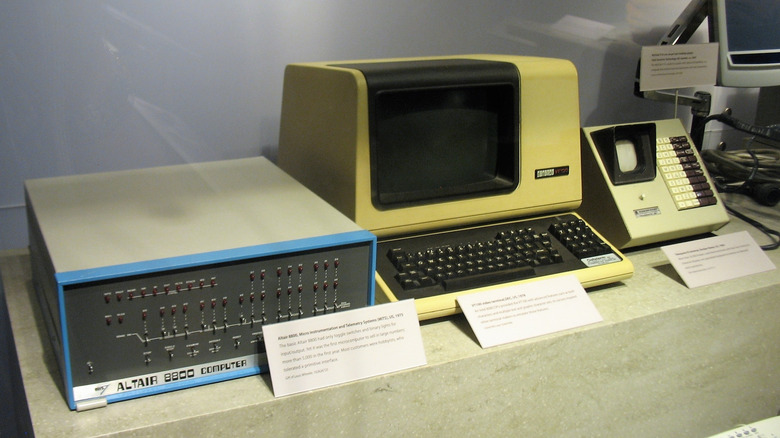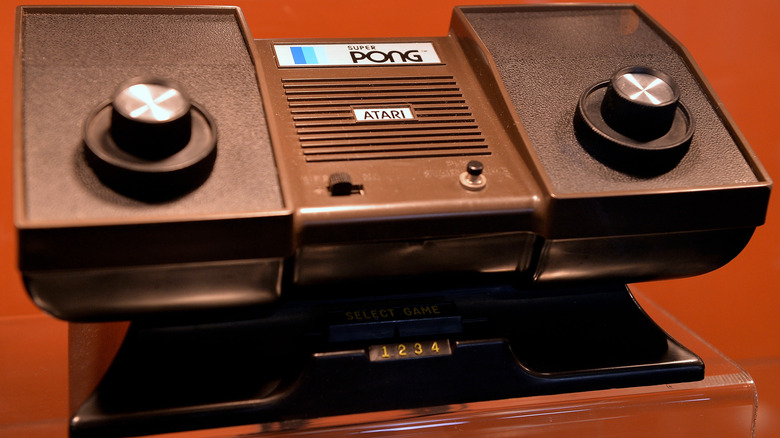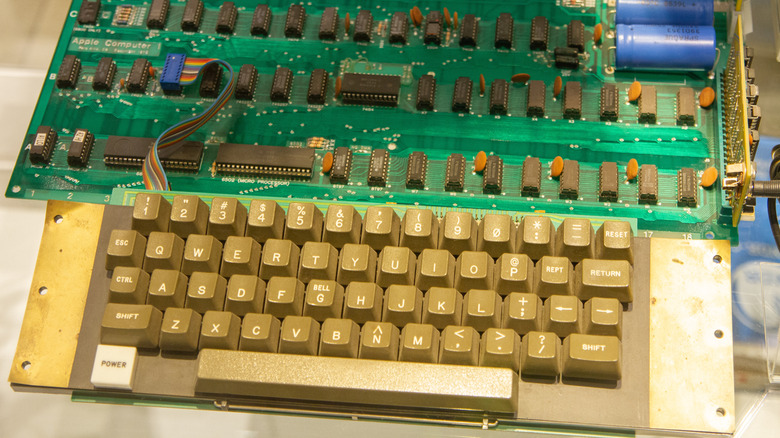The Hottest New Tech In 1975 That Blew Everyone Away
We may receive a commission on purchases made from links.
You might think that technology from 50 years ago was all very mundane, and there's truth to that, at least compared to the most exciting new devices coming out this year. But considering the limitations of the time, 1975 was a year of several breakthroughs, some of which even forged the path for devices we use today. After all, there is no advancement without the first innovation, and the value the title of being "first" holds shouldn't be underestimated. For instance, the first personal computers and digital cameras arrived in 1975, blowing everyone away and changing the technological dynamics forever.
Let's take a look at some of the developments of 1975 that paved the way for future thinkers and creators to innovate and lead further advancement. One thing to be noted here is that not all the inventions we're going to discuss about were necessarily invented in 1975, but they were still a significant part of that year or set the stage for later technological innovations.
Mood Rings
A rather unusual accessory hit the market in 1975 and instantly created waves among consumers. Mood rings were a genius creation of Maris Ambats and Josh Reynolds, who designed an out-of-the-ordinary wearable ring with a unique mechanism. The ring featured specialized thermotropic liquid crystals in the center that would change color according to your current mood. But how did it detect your mood? Through the temperature of your body.
Green means calm, black means stressed, violet is passionate, and blue is relaxed. Each color serves as an indicator for the user about their current emotions and feelings and whether they need to put in efforts into changing their current emotional state — sort of a biofeedback mechanism.
Everyone young and old rushed to grab their own mood rings and wear them like prized possessions on their fingers. The silver-plated rings were sold for $45, and the gold-plated ones cost around $500 after release. Endorsements from big-shot celebrities like Barbra Streisand and Count Dracula (Dracula, Prisoner of Frankenstein) had people rushing to jewellery stores to catch the newest fad, and thousands of units were sold in just a couple of weeks.
The trend has not completely vanished, too. People still search for it in hopes of adding to their "vintage" collection, and it is easily available on popular sites like eBay and Amazon.
Sony Betamax VCR
Sony introduced the Betamax VCR, priced at $2,295, in 1975 and it took the world by storm. The video cassette recorder gave consumers the ability record any show for later viewing. That meant families no longer had to wait by their TVs for a certain show to air, and the worry of missing an episode became a thing of the past.
The introduction of the Betamax VCR brought a home video revolution in America. For the first families to get a VCR, the purchase served as a reason for new social gatherings — it brought families and friends together to watch recorded shows. In the promotional video above by Venus Electronics, you can get a closer glimpse into the era of home video recording systems.
The Betamax Video Cassette System included a 19-inch Trinitron color TV enclosed in a wooden cabinet with two TV tuners, allowing you to record one show without interrupting the stream of another show simultaneously. What a concept! More than 18 million units were sold during the surprisingly short tenure of Betamax. Sony stopped producing VCR systems in 2002, followed by the final closure of Betamax tapes in 2015, as it could not compete with the newer VHS technology and lost the format wars.
Kodak's Digital Camera
In 1975, Kodak engineer Steve Sasson developed the first portable, battery-operated digital camera. We say portable, but the camera pictured above wasn't exactly pocketable. It had no option to view photos on a built-in screen. Rather, it had to be transferred to a cassette, which would then be used in a dedicated playback device that could convert the raw data in the cassette to a digital image and display it on a TV screen.
Surprisingly, Kodak did not release this camera publicly, but kept it hidden from fame within the walls of the company. For years it was nothing more than a mere prototype. In an interview with PetaPixel, Sasson discussed that he would take pictures of people with this camera, and when displayed on the TV screen, it "generally got everybody's attention." However, Kodak did not want to pursue the idea and was skeptical about its production, so management did nothing with it, only releasing its first digital camera 18 years later, a decision that may have contributed to the company's downfall.
The concept of filmless photography was revolutionary and paved the way for future technological advances. Sasson received the National Medal of Technology and Innovation award in 2009 and the Royal Photographic Society's Progress Medal in 2012 for his contribution to the digitization of photography. Despite the unfortunate series of events, the first digital camera left a mark in history that cannot be erased, even five decades later!
Altair 8800
The first ever personal computer, the Altair 8800, was a commercial hit when it released in 1975. The responsibility of launching the shocking innovation lay on the shoulders of Popular Electronics, which printed a first-page advertisement for the device, "the world's first minicomputer kit to rival commercial models." Get the complete kit for $395 and $498 for the assembled unit.
There was no way this could have failed. Computer fanatics, students, and practically everyone were fascinated with the idea of having a personal computer in their homes and rushed to grab their set. The success was visible in numbers. Altair 8800 had a backlog of 4,000 within the initial three months of launch.
The YouTube video above shows the experience of what it is like to load a "Star Trek" game on the Altair 8800. The computer took its sweet time to process and load the game over a cassette, but even this was the most technologically advanced personal computer of that time.
Fun fact: Bill Gates and Paul Allen started Microsoft with the intent to develop software for the Altair 8800.
Laser Printer
The laser printer was another cool invention that shook the world of tech in 1975. IBM developed the first ever commercially available laser-driven xerographic printer and it was as big as a room. The high-speed printer could print on a mass scale and made mass printing much more convenient, serving as a replacement for line printers.
It could tackle 167 pages per minute, which was super useful for banks, press printing, and other industries. Therefore, it quickly gained recognition. A user on Hackaday commented about using the printer for printing bank statements in the '90s and called it "a beast of a machine" due to its capabilities. Because it was something first of its kind, the audience had no knowledge about its usage, so IBM released an extensive training video guide to provide the printer's know-how.
No doubt, the modern laser printers serve an array of functions and are much more portable and convenient to use, but the IBM laser printer was the one that solidified the groundwork for this tech concept. And while we are at it, check out some of the best laser printers for your home. Don't worry, none of them will take up quite as much space.
Pong Home by Atari
Ask anyone who lived through the '70s and '80s about Atari, and they will definitely associate some memorable magic moments with the name. In 1975, Atari introduced Home Pong — a home version of its very popular arcade game.
The gameplay isn't as compelling as anything released today, but it triggered a massive craze when it released. Atari sold a massive 150,000 units of Pong in 1975. The console released just in time for Christmas, making kids around the country desperate to find one under the tree.
YouTuber Bret Weiss posted a video discussing his surprise when his cousin got Home Pong, since the concept of a video game in a room, paired with the simple fact that they could control images on a TV screen, was so new. Absolutely alien to the kids back then.
The game survived the harshness of five decades and remains popular to date, of course, with several modifications and advances to adapt to the changing times. However, the core idea remains the same. "Pong: The Arcade Classic" is a heavily downloaded version of the legendary game available on the App Store, while "Pong Quest" remains a popular game on the PlayStation Store.
Talk about timelessness, and this Pong is a prime example that revolutionized the video game industry for decades to come. Sadly, Atari lost its legacy somewhere in the passage of time, and now remains nothing more than a piece of nostalgia that transports us back into the good old times.
Magnavox Odyssey video game system
Owning the title of first-ever home video game console, the Magnavox Odyssey was released in 1972, but it was still very much hyped in 1975. Unlike the modern PlayStation or Xbox, this was a basic design made for simpler times.
The system had two handheld controllers, no in-game sounds, and very minimal graphics consisting of white lines and squares against a black background. It came with colored overlays to put on your TV screen to add some color to the gaming experience — not quite as fascinating as contemporary consoles. The BBC introduced the console to the world in an episode of its show, "Tomorrow's World," showing a hands-on gameplay tour.
Despite being the first in the video game console industry, it failed to build up much hype. During its lifetime, the Odyssey only managed to sell 350,000 units. Call it incompetent marketing, maybe? The promotional video of the game provided a tutorial on how to set up and play the video game for quality time together. The Magnavox Odyssey may not have been a commercial hit, but did paved the way for a bright future for the video game industry.
Apple I
Developed by Steve Wozniak in 1975, the Apple I was the first ever creation of the Apple Computer Company, which formed the basis of the entire Apple network. The system had an assembled motherboard, a keyboard, a mouse, a dynamic RAM, and a microprocessor — a complete computing unit for any home, unlike its predecessor.
Apple I was far better than all the computers that had made a mark until then, and showed the world how a fully assembled computer could be used within the comfort of your home. However, it was not a commercial hit; only 200 total units were produced, out of which only about 175 were sold. Of course, it also initiated the success of Apple, a brand we all can recognize today just by its logo.
In 2025, computer fanatics still consider the first set of Apple computers highly valuable. In 2021, a unit was sold for $500,000 at a U.S. Southern California auction, while another was sold for $375,000 in 2025.



